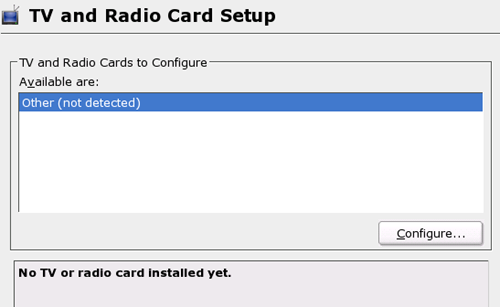Building a Linux PVR Part I - MythTV Setup and Install
by Kristopher Kubicki on September 3, 2004 12:05 AM EST- Posted in
- Linux
Installing the OS and Drivers
As a forewarning, this is not a replacement for the excellent MythTV documentation. We have only included our installation for completeness.SuSE 9.1 has a blindly simple installation, so we won't really go over that here. We used all default options while installing; everything went very smoothly. Although you may run YAST now for the online update, remember to re-run it again later if you install any RPMs. This is particularly true if you install the kernel-source RPM after you have already updated your kernel to a different version. For the remainder of our article, we will use the 2.6.5-7.104-default kernel.
Unfortunately - as we had somewhat expected - SuSE does not have very good support for Hauppauge hardware encoding PVRs. SuSE knows it's there; it just doesn't know what to do with it.


For us, the most painful part of the installation came when installing IvyTv, the open Linux drivers for iTVC15 found on the Hauppauge PVR-250. IvyTV (commonly called "ivtv") has a simple download page, and we opted for the 0.1.9 release found here. Since we will be compiling some kernel modules, we need to install the kernel-source package from YAST or via RPM. YAST solves all the dependency issues for us, so that is what we generally use.
Back in the ivtv driver directory, we go ahead and run make. If the Linux kernel source is installed correctly, within a few seconds, we should have working PVR kernel modules. We can attempt to load the card right now using the commands below:
# modprobe i2c-core
# modprobe i2c-algo-bit
# modprobe tuner type=2
# modprobe msp3400
# modprobe videodev
# modprobe saa7115
# modprobe ivtv










38 Comments
View All Comments
- Saturday, October 24, 2009 - link
sell:nike shoes$32,ed hardy(items),jean$30,handbag$35,polo shirt$13,shox$34Edster - Wednesday, September 22, 2004 - link
If you get stuck setting up mythtv then try this web site :[l=PVR Guide - How-to guides for setting up mythtv]http://pvrguide.no-ip.com[/l]
http://pvrguide.no-ip.com
sthes - Wednesday, September 15, 2004 - link
Whatever happened to part two? Anxiously awaiting the review!willy134 - Tuesday, September 7, 2004 - link
You need to mention the mythweb extension. I log into my computer from work and set up recordings. There are also plugins that allow you to view your recorded shows on a windows machine.The web server also has a very nice search feature and lists all the movies playing in your schedule. It's a great way to also find when a show you want to watch is playing again. Much better than looking up the listings on most web sites.
serff - Tuesday, September 7, 2004 - link
Can you guys comment on HDTV support in your follow up feature? I'm very intrested in building a HD DVR for less than $1000 (which is how much all of them are right now.) I'm also intrested in dual tuner solutions as well. Does MythTV support dual tuners? Also, in MythTV, when you go to the guide, can you still see the show you are watching? Like in the corner or something? It would also be cool to know about support for burning shows to DVD as well. Thanks!serff
sasa - Monday, September 6, 2004 - link
The system in the article is a total overkill if PVR-x50 is used.A 677MHz PIII can easily do the job.
Such system can be bought on ebay for $100, then just add 200GB hd for $100, GF4 for $40, PVR-x50 for $100. Total $340.
This system will do both front end and backend.
It is also possible to use very low spec PC for backend (like PII) and xbox as a frontend.
A Socket 370 PIII is consuming much less power than P4, K7 or K8 which is very important if you want to run Myth 24/7. You don't want to save $10 on tivo monthly bills while paying $20 for electricity bills.
Very nice distro for Myth is Debian unstable.
You just add a line into your apt config, run apt-get and it installs all dependencies.
sasa - Monday, September 6, 2004 - link
JohanV - Monday, September 6, 2004 - link
On the one side of the comparison: A windows MCE PC (hardware satisfying certain conditions + specialized preinstalled software)On the other side: A PC with approximately the same hardware with a general purpose SUSE Linux install, hand-compiled/hand-compiled drivers, databases and what not.
Not really a straight forward comparison, it's even worse than like comparing a server cpu with a desktop cpu.
Seems only fair to use handpicked hardware on both machines, and to use specialized OS's in both cases. In other words, use KnoppMyth with hardware that is known to work with KnoppMyth without any headaches.
griffy - Monday, September 6, 2004 - link
Anybody have any personal experience on the Telly MC1200, and how it might compare? I would be interested in a few words in Part II about how this option stacks up, in real terms. (Yes, I've read all the reviews.)Thanks for booting up an interesting area on AnandTech.
lbt - Monday, September 6, 2004 - link
Several people have mentioned KnoppMyth - no-one has said why...You insert the CD and it installs linux and *everything* you need to run Myth. (It aims to make running Myth 'appliance' like.)
For those who care it's a Knoppix (aka Debian) based distro.
Total install time is measured in minutes and you don't need to know linux (well, it's still at the 'not much' stage at the minute ;) )
Checkout www.mysettopbox.tv for forums and help.